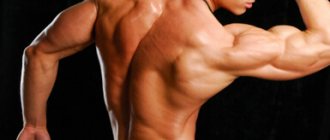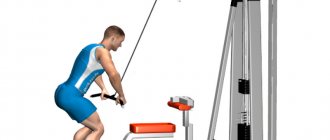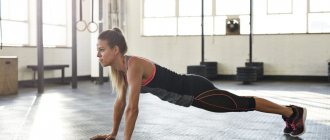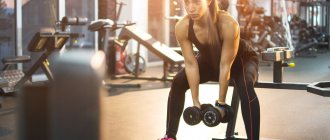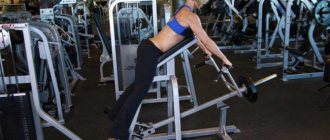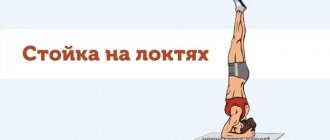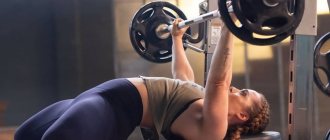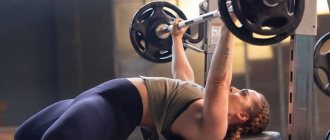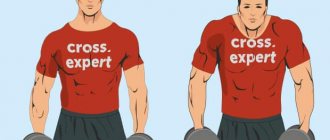Boxing school > > Practice > > How to pump up your back with push-ups
With the advent of gyms and a bunch of different exercise equipment, they began to completely forget about push-ups. But this is a fairly good and affordable exercise that allows you to keep your body in good shape and work out different muscle groups.
Push-ups are an integral part of any workout, both for beginners and professional athletes of any sport. Push-ups can pump up the latissimus dorsi muscles or wings. Therefore, if you do not have the opportunity to visit the gym, do not have a barbell or bench, or simply do not have enough free time, then you can replace this with push-ups.
Push-ups: how to do them correctly
Push-ups are the most popular bodyweight exercise. It is used not only in strength training, but also in plyometric exercises, CrossFit, Pilates, callanetics and even yoga. And such versatility of push-ups
easy to explain. Push-ups help you engage every muscle group from your neck to your toes, and especially strengthen your pectoral muscles, shoulder girdle, triceps, and abs.
There are many different types of push-ups, but before moving on to more complex modifications of this exercise, let's understand the technique of performing classic push-ups. The correct form of exercise is not only maximum results and high-quality muscle work, but also reduces the risk of injuries and damage
during classes.
Correct technique during classic push-ups:
- The body forms a straight line, the pelvis does not go up and does not bend down.
- The abdominal muscles are tense, but breathing is not held.
- The head is in a neutral position, not looking down, but not lifting up either.
- The palms are strictly under the shoulders and do not go forward.
- Palms face forward, parallel to each other.
- The elbows are turned back 45 degrees, they are not spread out to the side.
- As you exhale, bend your elbows and lower your body parallel to the floor, maintaining a straight line of your body.
- Push-ups are performed with full amplitude, i.e. the body drops as low as possible. Elbows should form a right angle.
It is this technique of classic push-ups that helps to evenly work the muscles of the shoulders, chest and triceps.
Push-ups work several muscle groups at once. This exercise allows you to work all the muscles of the shoulder girdle and the small stabilizing muscles of the shoulder. Also, push-ups from the floor and from the knees develop strength and elasticity of the shoulder muscles,
which is especially important since the shoulder joint is extremely unstable and susceptible to displacement and injury.
Push-ups help work the following muscle groups:
- Pectoralis major muscle
- Deltoids (shoulders)
- Triceps
- Serratus anterior muscle
- Abdominal muscles
In addition, during push-ups, the muscles of the legs, buttocks and back are indirectly involved in the work. Push-ups also increase functional strength.
necessary to perform regularly performed actions (lifting and moving objects, cleaning the house, holding a child in your arms).
Who is the exercise suitable for?
First of all, this type of push-ups is suitable for beginners who have started practicing at home. The exercise promotes muscle development of the entire shoulder girdle, and this is what beginner athletes need.
But for intermediate and advanced levels of training, wide-grip push-ups become too easy.
And if the average level can use the exercise at the end of the chest workout, as an additional exercise, or apply additional weight, then this will not be enough for more prepared athletes.
The advanced level does not practice push-ups during the mass-building period, but uses the movement during the drying period, when methods are used to increase the intensity of the load - reducing pauses between approaches, supersets, trisets, drop sets and the like.
In such conditions, training weights are sharply reduced, and even basic push-ups with a wide grip using your own body weight become a heavy movement.
The main mistakes in the technique of classic push-ups
Push-ups are not as simple an exercise as it seems at first glance. Errors in technique are made not only by practitioners, but even by coaches! Improperly performing push-ups can lead to injuries to the wrists, shoulder and elbow joints, as well as pain in the neck, back and lower back.
If you can't maintain proper form during push-ups, drop to your knees or reduce the number of reps! Train yourself to do this exercise correctly from the very first time you do it.
Elbows point in different directions
The most common mistake in push-up technique is the position of the elbows relative to the body. Keeping your elbows out helps compensate for lack of upper body strength. Of course, you can do this version of push-ups (which many people do)
.
But the problem is that this method of execution increases the risk of injuries to the shoulders and elbow joints
. Therefore, it is better to pay attention to the position of the elbows: they should be turned back 45 degrees, and not look in different directions.
Arms spread too wide
In classic push-ups, your hands should be strictly under your shoulders.
. Some practitioners practice push-ups with wide arms, but this is a weaker position in which your muscles do not work well enough. Additionally, wide-arm push-ups can cause shoulder pain over time.
Lifting the pelvis upward or bending the body
During push-ups, the body should form a straight line. But if you have a weak core, then there is a risk of poor push-up technique: lifting your butt up or, conversely, arching your lower back and lowering your hips towards the floor. Incorrect body position will put extra stress on the spine
. To avoid this mistake, start practicing the plank exercise - this will help strengthen your muscle corset.
Insufficient range of motion during push-ups
A very common mistake in the push-up technique is performing the exercise with incomplete amplitude, namely, not lowering the body down enough. Naturally, at first it will be difficult for you to perform push-ups with the full range, but train yourself from the very beginning of practical training to lower your body to a right angle at the elbow
.
For example, let's visually compare the correct and incorrect performance of push-ups.
1. Correct classic push-up:
The body forms a straight line, the pelvis does not rise up, the lower back does not bend. When doing push-ups, the body lowers low, the elbows are quite close to the body, the palms are under the shoulders.
2. Correct knee push-ups (simplified version of classic push-ups):
Similarly, the body forms a straight line, there are no deflections or bends in the back. We pay attention to the correct position of the palms relative to the shoulders.
3. Push-ups with an error:
The pelvis is lowered down, the lower back is curved, the straight line of the body is broken. Doing this exercise can cause back pain and even injury.
4. Push-ups with an error:
In this picture we see insufficient lowering of the body, the elbows barely bend. It is better to do 5 high-quality push-ups than 15-20 poor-quality ones, where the arms do not form a right angle.
Push-ups: benefits, harm and contraindications
Like any other exercise, push-ups have a number of advantages and disadvantages, as well as contraindications.
for execution.
This is a great strength exercise for developing muscles, but if done incorrectly or with weak joints, it can have unpleasant health consequences
.
Benefits of doing push-ups:
1. Push-ups are the best exercise to strengthen your chest muscles.
with your own body weight. If you want to get a good workout on your pectoral muscles, then push-ups should definitely be included in your training plan.
2. Push-ups are a multi-purpose exercise that works several muscle groups
. In addition to your chest, you'll strengthen your triceps, shoulders, and core. Push-ups also work your back, legs, and buttocks, providing a full body workout.
3. To perform push-ups, you do not need additional equipment. Plus, you can do this exercise both at home and outside.
. Are you on vacation? Don't have access to a gym? No problem, push-ups can be done anywhere you can find a small square of space.
4. Push-ups help strengthen your core muscles.
. This will not only bring you closer to a 6-pack abs, but will also be a good preventative for back pain and will also help improve your posture.
5. Push-ups are a very variable exercise.
. A wide arm position engages the shoulder muscles, while a narrow arm position engages the triceps. You can get a great upper body workout using just your own weight.
Anatomy of the back muscles
We will not delve too deeply into the construction of the human body, but will identify the main aspects. The back muscles are divided into main groups: deep and superficial.
Deep - make up most of the back:
- Rectus muscles - are extensors of the back, provide a person with posture, keep the body in an upright position.
- Transverse spinous – rotates to the sides, straightens the spine, pulls the head back, strengthens the spinal column. Located under the erector spinae muscle.
- Interspinous - muscle fibers that extend the spine and keep it in an upright position.
- Intertransverse - allow the spine to bend and also keep it in an upright position.
Surface – consist of two layers:
- Latissimus dorsi muscle. Occupies the entire lower back. Responsible for adduction and extension of the shoulder. Under special conditions, it can serve as an auxiliary respiratory muscle
- Trapezius muscle. Located in the upper back, from the lower edge of the shoulder blades to the cervical region. Responsible for raising the shoulders and returning the shoulder blades to their place.
- Rhomboid muscle. Located under the trapezius, connects the shoulder blades. Responsible for bringing the shoulder blades together at the back and holding them.
- Serratus muscles. Located parallel to the ribs. Responsible for raising and lowering the ribs.
- Muscles that lift the scapulae. Located under the trapezoid. They are responsible for raising the shoulder blades and participate in turning the neck.
How to learn to do push-ups from scratch: a ready-made plan
It's okay if you've never done push-ups before or had a long break from fitness and have lost this skill. Anyone can learn to do push-ups, regardless of gender or age!
Of course, you'll need regular practice, but learning how to do push-ups is not as difficult as, say, doing pull-ups.
The most important thing to remember if you want to learn how to do push-ups efficiently and effectively: you must always follow the correct technique.
from the very first repetition of the exercise. Even if you start with simple variations of the exercise, remember to use proper form and technique.
In order to start doing push-ups from scratch, we offer you a step-by-step program for beginners. Thanks to this scheme, everyone can learn push-ups!
A ready-made diagram of how to learn to do push-ups for beginners
In order to learn how to do push-ups, you will need to master 3 levels of push-ups
. You need to exercise daily, you need to perform 3-4 approaches with the maximum number of repetitions in each approach. Perhaps your first attempts will not allow you to do more than 5-10 push-ups, but every day you will progress.
If you feel like you haven't made the progress you want at the end of the week, then continue doing the same push-up modification for another week. It’s better to move to the next difficulty level after you can do 30-40 push-ups without interruption
. Don't forget about the correct push-up technique!
Week 1: Wall push-ups
Wall push-ups are an exercise that everyone can do. These vertical push-ups are a great introductory exercise that will help you master push-ups later on.
Week 2: Knee push-ups
The next level is knee push-ups. Please note that even when doing push-ups from the knees, the body should maintain a straight line, the pelvis should not go up.
Week 3: Push-ups
Once you have mastered knee push-ups, you can move on to bench push-ups. Attention, there is a nuance here. The higher the bench, the easier it will be for you to do push-ups. Therefore, you can change the height of the surface, thereby slowly preparing yourself for push-ups from the floor.
Week 4: Push-ups
After three weeks of regular push-ups, your body will be ready for push-ups. Remember that it is better to do fewer repetitions, but with full amplitude (elbows should bend 90 degrees).
You can continue to progress in push-ups by choosing the option with your feet resting on the bench
. There are also various more complex modifications of the exercises, which will be discussed below.
How many times should you do push-ups: ready-made push-up patterns
We emphasize once again that you should never chase quantity while neglecting quality. In addition, you don't always need to strive for more repetitions. How many times you need to do push-ups depends on your goals.
So, there are several possible situations:
1. If you want to pump up
and increase muscle mass in volume, then move towards increasing weight and complexity. For example, use barbell plates or elevate your feet on a bench. Training scheme: 10-12 repetitions of 3-4 approaches.
2. If you want to lose weight
and get relief, then move towards increasing the number of repetitions. Perform 15-25 repetitions in 5 sets. You can increase the total number of push-ups weekly or move on to more complex modifications.
3. If you want to develop endurance
and functional strength, then also move towards increasing the number of repetitions and choosing more complex modifications of floor push-ups, including plyometrics.
An example of a ready-made push-up scheme for increasing endurance and losing weight:
An example of a ready-made push-up scheme to increase muscle mass:
Example program
Depending on physical fitness and complexity of the exercise, the number of repetitions can vary between 10-20 times. The number of approaches also depends on the complexity of the workout. Perform 3-5 approaches, monitoring the sensations.
- Pull-ups on a horizontal bar or low bar.
- Rhino push-ups or handstands.
- Indian push-ups or dand.
- Narrow push-ups from the ball or from the floor.
- Dynamic plank - lifting from the forearms.
Also read: How to build big shoulders? All shoulder exercises → Middle deltoid exercises →
